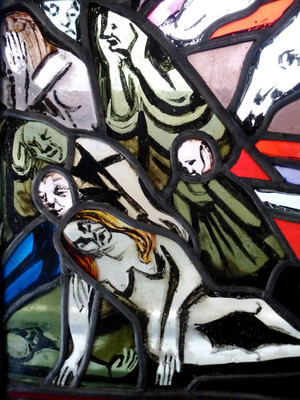Charles Hindenlang (1894-1960)
The Four Riders of the Apocalypse
(Revelation, VI, 1–8)
Charles Hindenlang
Basel, 1940
Signed
Handiwork of the artist
53 × 59cm
Clear and polychrome moulded glasses, red flashed glass, black vitreous paint, lead cames
Dokumentation
This stained-glass panel belongs to a six-part cycle that was executed between 1928 and 1942 and exhibited in 1968, in the context of a commemorative exhibition, at the Kunsthalle in Basel. At that time, all six panels were in private hands. They are Glücksrad (‘The Wheel of Fortune’), Garten Eden (‘The Garden of Eden’), Die Vier apokalyptischen Reiter (‘The Riders of the Apocalypse’), Gut und Böse (‘Good and Evil’), Die Vier Lebensalter (‘The Four Ages of Man’), and Himmlische und irdische Liebe (‘Heavenly and Earthly Love’). In the Revelation to St John (VI, 1–8) the four riders of the Apocalypse symbolize Victory (purity and justice), War, Hunger, and Death. Probably the most famous depiction of the riders is Albrecht Dürer’s woodcut of 1497/98.
In Hindenlang’s interpretation of the subject, the biblical coalesces with elements of the artist’s own invention, the inspiration for which may be found in his deep-rootedness in Alpine culture. As a result, he had a predilection for the demonic world and representations of the afterlife, which lived on in the Carnival tradition and Dance of Death murals of his home city of Basel.
The first rider (Victory) is represented in the centre of the picture, and instead of carrying the usual bow, he wears a green face mask (an animal head) and on his body a scaly, close-fitting green unitard, with a lit lamp on his right arm. The second (War), top left, storms on his horse down onto dying humanity, swinging a sword in his left hand. The third (Hunger), who is already wasted away to the point of death, sits on his horse behind the first rider, holding his hands to his ears, as if to block out the cries of the dying; the positioning of his arms is reminiscent of a pair of scales, the symbol ascribed to him in the biblical text. Finally the fourth rider (Death) tears across the foreground from right to left towards the dying, holding a flaming torch in his left hand. Beneath the body of this horse a light burns, casting light on the dead man under the earth below.
Hindenlang, perhaps affected by the Second World War that was raging in Europe at the time, has succeeded in producing a spine-chilling scene within the context of a tension-filled composition.
Print
Contact us
Biografie Charles Hindenlang



